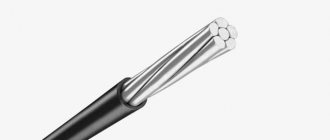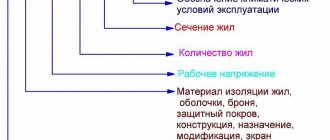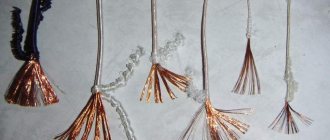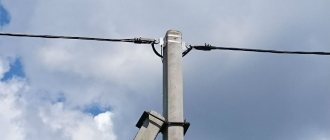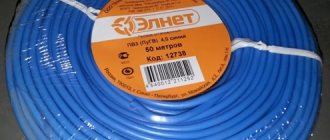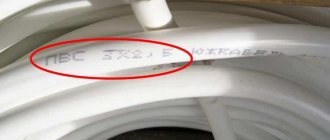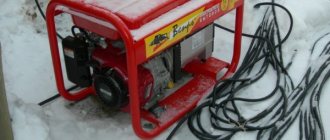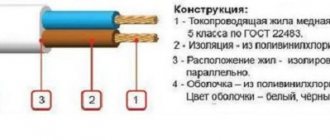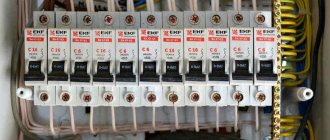The industry does not stand still. Old technologies are being brought to perfection, new ones are being born. Every day the number of electrical tools and household appliances operating from a 220/380 V network is significantly increasing. Accordingly, there is a need to use a unified, standard cable that could be used to connect electrical appliances to the network. Looking ahead, we note that this is what it is.
The specific choice is influenced by the features and operating conditions. It is important to choose the most durable, electrically and fireproof cable with increased flexibility and long service life. In addition to PVA, the best option for household appliances, there are other, less popular types of wires.
However, PVA can be operated at AC voltages up to 380 V, which is an ideal value for domestic use. Among the advantages, plasticity should be highlighted, which is influenced by the minimum bending radius. This allows you to maintain the integrity of the insulation and reduce the risk of ruptures of internal conductors.
Description of the PVS wire
PVS wire (also known as PVS cable) is one of the most common wires for household use.
It can be used to connect power tools (if the power consumption matches the wire cross-section), for laying lighting networks, and the like. As a rule, it is PVA wire or something similar that is used in household and industrial extension cords. Depending on the number and purpose of cores, this cable can be used in single-phase and three-phase networks.
Varieties
PVA can be divided into several varieties depending on the methods of operation and design. We are talking about internal and external, as well as copper and aluminum wires.
More details about each PVA option:
- The outer cable at least consists of three conductors, indicating phase, neutral and ground. This wire can be used to connect transformers and distribution panels.
- The internal one also consists of three cores, but is mainly used inside residential and industrial premises.
- Copper PVA is characterized by low resistance, elasticity and high strength.
- These indicators are no worse than those of aluminum cable. It is much cheaper, but is considered outdated technology.
The cost of a specific cable depends on several parameters:
- section;
- manufacturer;
- terms of Use;
- number of meters in the bay;
- technical execution;
- distance to the manufacturer (how much money was spent on transportation).
Purpose and use of PVS wire
The cable is often used:
- As an extension cord or carrying device for solving everyday problems;
- For external and internal connections of external electrical networks and devices;
- In gardening due to its flexibility and waterproofness;
- Inside electrical devices;
- For connecting any type of power tools (personal computer, lawn mower, electric kettle, TV, vacuum cleaner, etc.).
Important! PVS has a huge number of appointments. It is used even where no one expects to find it. All thanks to its flexible structure and performance characteristics. It is because of this that such a huge production of PVA has been established in the world by manufacturers from different countries.
PVA based carrier
Decoding the PVS wire
For PVC wires, the decoding is quite simple - “P” means wire, “B” means the presence of vinyl insulation (this is an abbreviation for PVC) and “C” means the connection of all cores in a single sheath. In this case, the wire has a circular cross-section. The addition of the symbol “P” indicates a parallel arrangement of cores. In this case, the wire has an oval shape.
Decoding of PVS wires
So:
- The marking on the wire is applied to its outer surface . In addition to the designation of the wire brand, it also contains a number of numbers. Let's look at their meaning. And the video presented on the site will help us in this.
- The first digit after the letter marking is “2”, “3”, “4” or “5”. This number indicates the number of cores in the cable.
- After this comes the “×” sign and the second number, which can be “0.75”, “1.00”, “1.50”, “2.50” . This number means the cross-section of all wire cores.
Note! According to GOST 22483 - 77, the nominal and actual cross-sections of the cores may differ. The main requirement is that the electrical resistance of the wire meets the standards.
- For example, we have a flexible wire PVA 3x1 5. This means that this wire has three cores with a nominal cross-section of 1.5 mm2 each.
Marking
For existing brands of PVC, the decoding of designations has the following standards (GOST 7399-97):
- Tinned copper as phase wires - PVSL;
- Antiseptic additives in the insulation material - PVST;
- The flat section of the outer insulating layer is “ShV”;
- Reinforced outer protective shell - “B”;
- The insulation material has increased combustion resistance - “PS”.
In addition to the letter code, the PVC cable marking contains numbers, which are deciphered in the following order:
- The number of conductors is indicated by the first digit.
- After the “x” icon follows the cross-sectional area of 1 core in millimeters:
| Two-core | Three-core | Four-core | Five-core |
| 2x2.5 | 3x2.5 | 4x2.5 | 5x2.5 |
| 2x1.5 | 3x1.5 | 4x1.5 | 5x1.5 |
| 2x1 | 3x1 | 4x1 | 5x1 |
| 2x0.75 | 3x0.75 | 4x0.75 | 5,0,75 |
The same numbers indicate the weight of 1 km of the product:
| 0.75 mm² | 0.1 mm² | 1.5 mm² | 2.5 mm² | |
| Two-core | 55.8 kg | 66.1 kg | 79.8 kg | 102 kg |
| Three-core | 63.7 kg | 76.5 kg | 96.5 kg | 118.4 kg |
| Four-core | 85.15 kg | 107 kg | 134.5 kg | 170.6 kg |
| Five-core | 133 kg | 166.7 kg | 203.8 kg | 257.6 kg |
Technical characteristics and operating conditions
According to the current GOST, this type of wire must meet the following standards:
- The lower limit of the operating temperature range is 20°C below zero, permissible long-term heating is 40-50°C, short-term heating is not more than 70°C. Frost-resistant design is possible, in this case the lower threshold drops to -40°C.
- The rated voltage is 380 V, but the insulation must withstand a short-term increase of up to 2000 V (at least 5 minutes). It is under these conditions that tests should be carried out by the manufacturer.
- PVA insulation of any type should not spread fire if a single installation was carried out. When laying in groups, this requirement applies only to wires marked “ng” in the marking.
- Failure-free operating time in hours is at least 5000; when used in stationary installations, this parameter increases to 12000; in years this is 6 and 10 years, respectively.
- The threshold of permissible relative humidity should not be lower than 98%.
- Mandatory resistance to the destructive effects of fungi and mold.
The remaining parameters are shown in the table below.
Characteristics
PVS wires have the following technical characteristics:
- Depending on the cross-section of the phase elements, the product can withstand current up to 2 kW;
- When stretched, rupture occurs after the length has increased by one and a half times;
- The optimal operating temperature ranges from plus 40˚C to minus 25˚C;
- Frost-resistant grades of PVA are marked with a special symbol “Y”. It indicates a lower temperature threshold of up to - 40 ˚C;
- The warranty period is usually 2 years;
- When laid alone, the shell of the product does not support combustion. In case of fire during prolonged contact with an open flame, it has the property of self-extinguishing;
- PVA-T has a coating that has a number of special properties that increase service life in hot and humid climates;
- Can be used at high air humidity (up to 98%);
- The safe bend radius is at least 4 cm;
- The resource of uninterrupted operation when used as a temporary wiring or carrying element is 5000 hours. When used as stationary and permanent wiring - 12,000 hours.
A PVS cable from different manufacturers may have different technical characteristics, even if the markings are the same. Differences may relate to parameters such as:
- Thickness of the insulating layer;
- Conductor cross-section;
- The number of copper wires in the strand.
An exact description of the properties of a particular PVA can be found in the supplier's documentation.
Watch this video on YouTube
Basic parameters of PVS wire
Now let's look at the main characteristics of the PVS wire. After all, it is on the basis of them that the choice of wire and location of its installation is made.
Technical characteristics of PVS wires
So:
- According to GOST 22483 - 77 cores of PVS wires belong to class 5. Based on this, the cross-section of individual wires in the total cross-section of the core is selected. For example, for a wire with a nominal core cross-section of 1.0 mm2, the cross-section of a single wire should be no more than 0.21 mm2. And for a core of 2.5 mm2, the value of a single wire should no longer be more than 0.26 mm2.
- As for insulation, GOST 7399 - 97 PVS sets values for wires that depend on the cross-section of the cores. So the thickness of the core insulation ranges from 0.6 to 0.8 mm. And the thickness of the shell ranges from 0.8 to 1.2 mm. In this case, the insulation must provide an insulation resistance not less than those given in this GOST.
Note! According to clause 4.1.1.6 of GOST 7399 - 97, the wire sheath should not have any bulges or dents. In addition, the shell must be made in such a way that there are no voids between the cores. It is allowed to use additional materials for this. But in any case, separating the cores from the shell should not cause difficulties.
- Operating temperatures for PVA wire are considered to range from - 25⁰С to +40⁰С. In this case, the maximum operating temperature should not exceed +70⁰С. And the minimum temperature for installation should not be lower than -20⁰С
- The instructions assume that the wire sheath does not spread fire. At the same time, it itself is exposed to temperatures.
- GOST measures the service life of PVA wires at 6 years. But usually this period is much longer, unless the wire is exposed to aggressive environments.
What regulatory documents regulate the use of
Household extension cord
When manufacturing PVS, they are guided by the requirements of GOST 7399-97. The section includes basic information about the product range, a list of tests, and safety requirements. The technical standard regulates the basic mechanical and electrical threshold data. The manufacturer may change individual specific figures within the specified acceptable limits.
In accordance with GOST, the wire can have 4 versions according to the number of cores. The cross-sectional area of the cores varies from 0.75 to 16 mm2. Products with maximum parameters are produced only by cable factories.
According to the standards, twisting of a wire of 0.75–2.5 mm2 should be done in the left direction, without filler.
When working in a mobile position, the service life is 6 years. In static mode, the service can last up to 10 years.
Additional designations
The PVS cable may be marked with a number of additional letters and/or numbers indicating individual design features or functional properties. First of all, this is a 3x2.5 format code - a standard designation of the number of cores and their total (since they are multi-wire) cross-section.
Other possible designations:
- T - “tropical” version, increased resistance to humidity.
- Y - increased temperature range (up to –40 degrees).
- L - conductors made of tinned copper.
- A - conductors are made of aluminum, not copper.
- B - presence of armor.
- G - no insulation.
- PS is a shell made of a mixture of polyethylene and polyvinyl chloride.
- PV - shell and mixture of PVC with rubber mass.
KSPV
The KSPV cable is a signal wire used for fixed internal installation when connecting alarm systems, communications and messages in networks.
Its name is deciphered as follows:
- K - cable.
- SP - transmission systems.
- B - in a vinyl shell.
KSPV insulation consists of polyethylene and is hidden behind a polyvinyl chloride shell. The most common type is without insulation.
Specifications
The KSPVG cable has the following technical characteristics:
- Contains at least two cores. They can be made of aluminum and copper. There is no insulation.
- The service life of the product is at least 15 years when used in temperatures ranging from -40 to 70 degrees Celsius.
Explanation of cable markings
The names of cables may contain various letters that determine their additional characteristics:
- A - the core of the aluminum core.
- B - reservation.
- BPI - wire cores are equipped with a paper layer impregnated with a non-flammable substance.
- B - insulation consists of paper.
- G - no insulation.
- KG - increased flexibility.
- NG - not subject to combustion.
- P - insulation is based on polyvinyl chloride.
- PS - insulation based on polyvinyl chloride using polyethylene.
- PV - the shell consists of polyvinyl chloride and vulcanized rubber.
- R - rubber insulation.
- C - lead insulation.
- F - power cord.
- ShV - flat shell made of polyvinyl chloride.
Application area
Cables of the KSPV brand are used for installation of alarm systems and telecommunications with operating voltages up to 250 V AC. For internal fixed installation of communication systems. The price of KSPV is quite reasonable, so it is a good budget option for direct installation of network connections.
Types of insulation
Insulation types:
- Polyvinyl chloride (PVA). PVA is a relatively inexpensive and easy-to-use material that can be used in a variety of applications. The maximum temperature range is from minus 55 to 105 degrees Celsius. The polymer is resistant to flame, moisture and abrasion. It also resists gasoline, ozone, acids and solvents. It can also be used for medicinal and food purposes as it is odorless, tasteless and non-toxic. PVA shells can be used in heavy and thin-walled structures. PVA should not be used when flexibility and extended flex life are required at low temperatures. It also exhibits below-average flexibility when used in devices with retractable cords. PVA shells exhibit high attenuation and capacitance loss, meaning that power is lost when used in an electrical system.
- Semi-rigid PVC (SR-PVC). Mainly used as primary insulation and very resistant to abrasion. (For thicknesses 30-16, 10mm wall is UL 1061 style, 80 degrees Celsius, 300 volts.) Semi-rigid PVA is fire resistant and also resistant to heat, water, acids and alkalis.
- Plenum Polyvinyl Chloride (Plenum PVC). Plenum PVC is suitable for use in areas behind drop ceilings or raised floors that are left open to allow air circulation. Standard PVA is considered a non-film insulation option because it does not have the qualities required for safe indoor use. To achieve rated density, insulation must meet more stringent fire codes.
- Polyethylene (PE). This connection is used most often in coaxial and low capacitance cables due to its typical electrical properties. Many times it is used in these applications because it is affordable and can be foamed to reduce the dielectric constant to 1.50, making it an attractive option for cables requiring high speed transmission. Polyethylene can also be cross-linked to provide high resistance to cracking, cutting, soldering and solvents. Polyethylene can be used at temperatures from minus 65 to 80 degrees Celsius. All densities of polyethylene are rigid, hard and inflexible. The material is also flammable. Additives can be used to provide fire resistance, but this will sacrifice dielectric constant and increase power loss.
- Polypropylene (PP). This material is very similar to polyethylene, but has a wider temperature range from minus 30 to 105 degrees Celsius. It is mainly used for thin-walled primary insulations. Polypropylene can be foamed to improve its electrical properties.
- Polyurethane (PUR). Polyurethane is known for its extreme strength, flexibility and flexural life, even at low temperatures. This material also has excellent ratings for chemical, water and abrasion inertness. This material works well when used with a retractable cord and can be an excellent option for salt spray and low-temperature military applications. Polyurethane is a flammable material. The fire-resistant version sacrifices durability and surface finish. However, the main disadvantage of polyurethane is its poor electrical properties, which makes it only suitable for jackets.
- Chlorinated polyethylene (CPE). CPE has very good resistance to heat, oil and weathering. Many times CPE serves as a cheaper, environmentally friendly alternative to CSPE. Its reliable performance under fire also makes it an advantageous replacement for PVA insulation. Chlorinated polyethylene is commonly used in power and control cables and in industrial power plants.
- Nylon. Nylon is usually extruded over softer insulating compounds. It serves as a tough shell exhibiting high abrasion, cut-through and chemical resistance, especially in thin-walled applications. It is also an extremely flexible material. One of the disadvantages of nylon is its ability to absorb moisture. This degrades some of its electrical properties.
Design
Modern PVA wire consists of several intertwined copper wires with separate insulation made of high-quality polyvinyl chloride. Additionally, all conductors are protected by a PVC sheath. The standard cable has a round cross-section, although the PVSP model, as described above, will have an oval cross-section. Insulating materials may include various additives that give them additional protective functions (for example, the product does not support the combustion process).
Each copper core contains a large number of copper wires. When twisting each one, a dense rope is formed. In accordance with GOST, the class of lived in PVA must be at least fifth. Such a standard automatically regulates the minimum thickness of the wires from which a separate core is formed.
If the cross-section of each core in the cable is 1 sq. mm, then the diameter of the wires used should not be lower than 0.21 mm.
According to the standards specified in GOST, the wire can be produced in the following versions: with two, three, four or five cores. The cross-sectional area varies between 0.75-16 square meters. mm. Thicker types of cable are produced in specialized factories and are necessary for industrial use.
Analyzing GOST, you can discover another important rule: in PVA, the cores are twisted in the left direction, but the density is so high that filler is not used.
When choosing an insulating shell, manufacturers try to use materials of different colors, which simplifies installation tasks. Individual wires can be colored blue, brown, red, yellow or even yellow-green. The phase conductor is usually marked brown or red, the neutral conductor is blue or cyan, the ground conductor is double, yellow-green. The common sheath, under which all the cores are located, can have an arbitrary color (for example, black).
The top, outer layer is a polyvinyl chloride shell, which is applied using the extrusion method. During the single installation process, the protective layer does not support combustion. Due to its plasticity, the sheath fills any gaps formed between the cores, making the wire round in shape. The maximum eccentricity value is 10%.
Marking
The general insulation and shell of phase conductors are marked in accordance with the PVA color marking standard:
- The overall insulating sheath is always painted white. Sometimes there are two diametrically located stripes of a different color.
- Black, red, yellow, gray and brown colors are used to mark conductive wires.
- If there is a “zero” phase, it is indicated in blue.
- Green or yellow-green color is reserved for the ground wire, but it is rarely found in PVA.
Marking of PVS wires is carried out in accordance with the requirements of GOST 7399-97. Decoding the notation is very simple:
- the presence of the letter “l” indicates that the phase wires are made of tinned copper (PVC);
- the capital letter “T” indicates the climatic design of the cable;
- “A” in the marking means that the cable uses aluminum conductors;
- “B” - armored wire;
- PS - the cable insulating sheath is made of a mixture of self-extinguishing polyethylene and polyvinyl chloride;
- G – cable without insulation;
- ШВ – outer insulating shell made of flat polyvinyl chloride;
- PV - the outer insulating shell is made of a mixture of PVC and vulcanized rubber;
- the first number following the letter designations indicates the number of cores inside the cable;
- the number following it is the cross-sectional area of the conductive conductors.
In order to find out the exact physical characteristics of the PVA cable, you should refer to the following table:
| The wire | Number of cores/sectional area of each (mm2) | Number of wires in phase conductors/diameter | Weight of 1km cable (kg) | Outer diameter (mm) | Max Diameter(mm) |
| PVS | 2×0,75 | 24×0,2 | 55,8 | 6,4 | 7,2 |
| 2×1,00 | 32×0,2 | 63,7 | 6,7 | 7,5 | |
| 2×1,50 | 30×0,25 | 85,15 | 7,6 | 8,6 | |
| 2×2,50 | 50×0,25 | 133 | 9,4 | 10,6 | |
| 3×0,75 | 24×0,2 | 66,1 | 6,8 | 7,6 | |
| 3×1,00 | 32×0,2 | 76,5 | 7,1 | 8 | |
| 3×1,50 | 30×0,25 | 107 | 8,3 | 9,4 | |
| 3×2,50 | 50×0,25 | 166,7 | 10,2 | 11,4 | |
| 4×0,75 | 24×0,2 | 79,8 | 7,4 | 8,3 | |
| 4×1,00 | 32×0,2 | 96,5 | 7,9 | 9 | |
| 4×1,50 | 30×0,25 | 134,5 | 9,2 | 10,5 | |
| 4×2,50 | 50×0,25 | 203,8 | 11,1 | 12,5 | |
| 5×0,75 | 24×0,2 | 102 | 8,3 | 9,3 | |
| 5×1,00 | 32×0,2 | 118,4 | 8,7 | 9,8 | |
| 5×1,50 | 30×0,25 | 170,6 | 10,3 | 11,6 | |
| 5×2,50 | 50×0,25 | 257,6 | 12,4 | 13,9 |
This is interesting: How to check the voltage in an outlet with a multimeter and a screwdriver (video)
Colors
The above GOST does not impose any special requirements for the coloring of external insulation; 10 color options are allowed: white, black, gray, etc.
As for the color of the core insulation, it must correspond to the table below.
The color chart for insulation is live depending on their purpose and quantity:
| Number of cores | Accepted color standard | |
| there is a grounding conductor | No grounding conductor | |
| 2 | brown, blue | |
| 3 | yellow-green, brown, blue | black, brown and blue |
| 4 | yellow-green, black, brown, blue | blue, black, brown, black or brown |
| 5 | yellow-green, blue, black, brown and black or brown | blue, black, brown, black or brown, black or brown |
The purpose depending on the color of the insulation is shown in Figure 3.
Figure 3. Colors according to GOST for neutral, protective and phase conductors
Please note that sometimes the insulation of the phase conductor is also white, which is acceptable according to the international standard.
Having finished with the design features and color designation, let's move on to the description of the main parameters.
Service life of PVS wire
The service life should be indicated on the cable label when purchasing the cable. On average, the service life of such a carrier is stated to be up to 5 years, but in fact, under the right operating conditions in a normal environment, the cable can operate smoothly for more than 10 years. If the environment in which the wire is used is aggressive or humid (hot), then the service life will naturally be reduced.
Having studied the description of PVS cable, what it is, what types it comes in and what technical and operational characteristics it has, it is clear why it is used not only by electricians, but also by a huge number of people around the world to solve various problems.
Insulation material: description
The vinyl-sheathed connecting wire owes its name to the material used to insulate live parts—polyvinyl chloride resin. It does not burn in air, is frost-resistant and invulnerable to acids, alkalis, solvents and mineral oils.
All kinds of chemical elements: talc, calcium carbonate and kaolin, plasticizers and stabilizers are part of the plastic and improve its performance characteristics.
Dyes allow you to obtain insulation of different colors. PVC insulation is environmentally friendly and does not harm the environment. It is the main advantage of the cable, as it is made of fire-resistant material.
Can PVS wire be used outdoors?
Flexible wire PVA (GOST 7399-97) is equipped with polyvinyl chloride insulation and consists of copper cores. It is intended for connecting to an electrical network with a voltage of up to 380/660 V household electrical appliances of various types and devices of similar applications (refrigerators, washing machines, microclimate devices). Including in small mechanization tools for gardening - in situations where the wire is subject to chafing and moisture.
There are no prohibitions on outdoor use, but it is worth considering that the wire has a multi-wire core, which is more susceptible to corrosion, unlike a monolith. Also, the PVA wire quickly picks up moisture, which remains inside.
Wire or cable
The scope of application of this type of electrical product overlaps with areas in which similar cables are used. Therefore, the question may arise - is it a wire or is it a cable, and if the areas of application and technical capabilities are related, then how do a wire and a cable differ?
From a technical point of view, it is still a wire. Even the labeling (discussed in the article below) indicates this. To match the cable's rank, the PVS does not have the same technical characteristics.
A cable is, first of all, a rather complex composite system of several conductors, each of which has its own insulation, supplemented (in various versions) with intermediate insulating layers, armor, one or more layers of protective sheaths, and so on. The design of the wire is much simpler - one or several cores in individual insulation, a common sheath that protects from external influences and at the same time serves as an additional insulator. All.
Wires, including PVS wire, are more flexible and lighter than (on average) cables. Therefore, they are more convenient for indoor wiring, but are never used for transmitting electricity over long distances.
Features of installation of PVA for laying in the ground and outside
The first thing you should pay attention to is that PVA wire is not intended for underground installation. If this is absolutely necessary, then the product should ideally be hidden inside a double-walled pipe. When laying cables outdoors, it is necessary to use corrugated pipes attached to walls and other surfaces of stationary objects. In this case, grounding must be carried out.
If you need to create an overhead power line using a PVA wire, then choose a cable exclusively with copper conductors. In this case, the distance between the beginning and end of the route should be minimal. Hidden wiring from PVC cable is unacceptable (it cannot be hidden under plaster).
Despite the fact that the cable has a short service life (for electrical wiring in a house, six years is really not enough), it can be used when laying under a screed. This option is appropriate if you want to save money on purchasing a higher quality and more durable wire. Thanks to a set of unique properties and protection from dust and moisture, PVA can be used in rooms with high humidity levels.
Load current
Current loads are directly related to the permissible power of the connected devices. This is the general value when connected to a separately operating circuit with an individual overload protection unit. If the standard values are exceeded, overload, overheating, insulation failure, short circuit, and fire occur. How serious the consequences will be depends only on the speed at which the circuit breakers operate. It is better to exclude this at the stage of calculations for the project and lay the cable with a “margin of safety”.
Advantages and disadvantages of PVA
The PVS cable is inconvenient when installing hidden wiring, as it has a round shape
The main advantage is the relatively light weight, softness and flexibility of the cord. This makes it possible to install in complex systems, structures with a steep transition radius, a large number of bends and turns.
Can be used in electrical networks of 220 and 380 volts. The wire has a standard fire resistance class. The insulation material does not ignite from an external flame and does not support combustion. It is not recommended to use it for hidden installation, since its service life is no more than 6 years. Having a round cross-section, it is inconvenient for installation under plaster.
PVA has found wide application and is in great demand among buyers. However, for electrical wiring it is better to choose the cable VVG, VVGng, or another analogue that is most suitable for this purpose.
PVS cable compared to VVG
In terms of technical and operational characteristics, VVG is superior to PVA wire, however, these models have different purposes.
When organizing electrical wiring in a house, apartment, or industrial facilities, it is best to use a VVG cable, since this is its main purpose.
PVA is used where VVG is inappropriate and can spoil the overall picture. Or in any other situations when it is inconvenient to operate the VVG cable due to its higher rigidity. For example, it would be difficult to imagine a VVG used to switch a microwave oven, iron or hair dryer. It looks ridiculous, extremely irrational, so in this case there is no alternative to PVA.
VVG also cannot be used when arranging temporary street lighting, constructing extension cords for connecting a lawn mower, cords for connecting boilers and expansion tanks. Thus, it is inappropriate to compare VVG and PVS in terms of technical parameters, since these conductors are designed to solve completely different problems.
Conclusion
Due to the fact that PVA wires have more than satisfactory characteristics, their scope of application is growing every day. Simplicity of installation, ease of operation and high technical parameters allow it to be used for almost any purpose by both professionals and amateurs. And the quite affordable price of PVA copper wires further expands the scope of their application.
When choosing a PVS cable, technical characteristics are not always put at the forefront, since its main advantage is cost. However, this does not prevent the wire from being quite reliable if the cross-section is selected correctly and used under recommended conditions.
How to choose PVS wire
The first thing you should pay attention to when choosing any electrical cable or wire is the number and cross-section of cores, selected in accordance with operating conditions. You need to select a PVA depending on the power of the electrical appliances that will be switched to the network through it. The presence or absence of a grounding conductor, which allows connecting the electrical appliance and the ground loop, is important. For example, when laying an industrial network, you need to use a PVA with four cores. At least, this is how it is stated in the rules of the PUE.
When inspecting the product, make sure that there are no defects in the insulation and that it is of proper quality. Test it for strength, since the insulation should not be damaged or torn by touch. Otherwise, the cable will not last long and will also pose a danger.
Each manufacturer must submit a sample of their wire. While studying it, make sure that the individual core is twisted correctly. Poor quality can be judged by the presence of stains, breaks, different colors and other defects that are visible to your eye. On the marking you can see not only the number of cores and their cross-sectional area, but also find out about the percentage of copper content.
To ensure safe and energy-efficient operation of electrical equipment, it is important to select the appropriate PVS wire. If you encounter any difficulties in the process of choosing a product, then seek help from professional installers or store consultants. However, you should not believe every word of the latter. Ideally, you should study the basic information regarding PVA and, armed with knowledge, go shopping.
Description of non-flammable analogue
Among the analogues of this brand, we can highlight the PVSng-LS wire. Its scope of application in a network of various devices is varied. It is also widely in demand for connecting electrical appliances that require increased fire safety to the network. The decoding of the last four letters of the abbreviation PVSng-LS means:
- ng - non-flammable cable,
- LS – in case of fire, low smoke and gas emissions.
Structurally, PVSng-LS wires belong to class 5 according to GOST 22483-77. Provided that the number of cores is 7, digital markings are applied to their insulation. All insulated conductors are twisted.
Wires, where the number of cores is 5, are twisted into a core.
